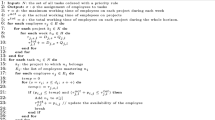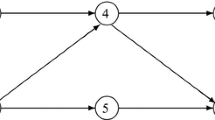Abstract
In a multi-project environment, we sometimes need to periodically schedule the tasks for each project and assign staff to the tasks. Such a decision-making problem has been studied in literature; however, learning effect of staff has not been considered in previous studies. This research formulates a mixed nonlinear program for project scheduling and staff allocation problems, which considers learning effect of staff. The objective function is to minimize outsourcing costs. A genetic algorithm (GA) is proposed to solve the problem. Experiments for solving various sizes of test problems has been carried out to validate the proposed GA.
Similar content being viewed by others
References
Campbell GM, Diaby M (2002) Development and evaluation of an assignment heuristic for allocating cross-trained workers. Eur J Oper Res 138:9–20
Campbell GM (1999) Cross-utilization of workers whose capabilities differ. Manage Sci 45:722–732 Bassett M (2000) Assigning projects to optimize the utilization of employees’ time and expertise. Comput Chemical Eng 24:1013–1021
Miller JL, Franz LS (1996) A binary-rounding heuristic for multi-period variable-task-duration assignment problems. Comput Oper Res 23(8):819–828
Urahama K (1994) Analog circuit for solving assignment problems. Trans IEEE on CAS-I 41(5):426–429
Xu HB, Wang HJ, Li CG (2002) A hybrid algorithm for the assignment problem. In: Proceedings 2002 International Conference on Machine Learning and Cybernetics, 2:881–884
Bassett M (2000) Assigning projects to optimize the utilization of employees’ time and expertise. Comput Chemical Eng 24:1013–1021
Hendriks MHA, Voeten B, Kroep L (1999) Human resource allocation in a multi-project research and development environment. Int J Project Manage 17:181–188
Hanakawa N, Morisaki S, Matsumoto K (1998) A learning curve based simulation model for software development. In: Proceedings of the 1998 (20th) International Conference on Software Engineering, 350–359
Wright TP (1936) Factors affecting the cost of airplanes. J Aeronautical Sci 3:122–128
Yelle LE (1979) The learning curves: historical review and comprehensive survey. Decis Sci 10(2):302–328
Smith DB, Larsson JL (1989) The impact of learning on cost: the case of heart transplantation. Hospital Health Service Administration 34(1):85–97
CPLEX (2002) User’s Manual, ILOG CPLEX 7.5CEnoteincomplete ref. info
Gen M, Cheng R (2000) Genetic algorithms and engineering optimization. Wiley, New York
Goldberg DE (1989) Genetic algorithm in search optimization and machine learning. Addison Wesley, New York
Man KF, Tang KS, Kwong S (1999) Genetic algorithms. Springer, New York
Winston PH (1992) Artificial intelligence. Addison-Wesley, New York
Author information
Authors and Affiliations
Corresponding author
Rights and permissions
About this article
Cite this article
Wu, MC., Sun, SH. A project scheduling and staff assignment model considering learning effect. Int J Adv Manuf Technol 28, 1190–1195 (2006). https://doi.org/10.1007/s00170-004-2465-0
Received:
Accepted:
Published:
Issue Date:
DOI: https://doi.org/10.1007/s00170-004-2465-0




